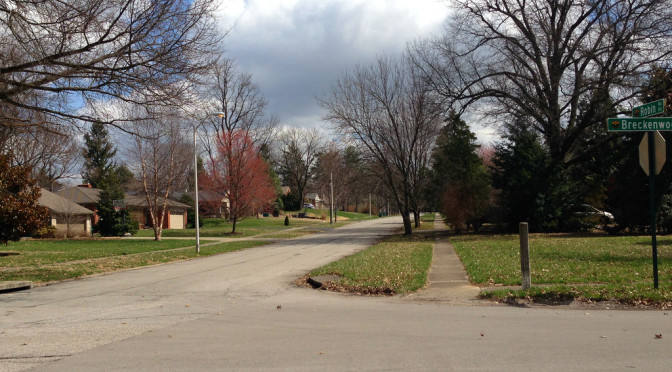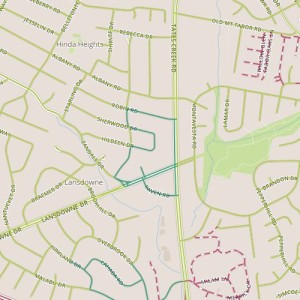 Today brought me back to the Lansdowne area, and my path focused on the northwest side of the Lansdowne/Tates Creek intersection. The houses and lots here are large by urban standards. The landscaping tends to be more wild–not so much of the manicured but bland look that I see in brand new neighborhoods with similar size lots. There were probably enough interesting things to mention on there own, but because of its proximity to two recent multi-modal infrastructure projects, I wound up really focusing on the challenges involved in improving Lexington’s walkability and bikability.
Today brought me back to the Lansdowne area, and my path focused on the northwest side of the Lansdowne/Tates Creek intersection. The houses and lots here are large by urban standards. The landscaping tends to be more wild–not so much of the manicured but bland look that I see in brand new neighborhoods with similar size lots. There were probably enough interesting things to mention on there own, but because of its proximity to two recent multi-modal infrastructure projects, I wound up really focusing on the challenges involved in improving Lexington’s walkability and bikability.
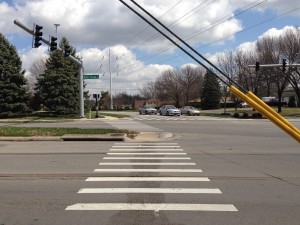
Lexington recently added a sidewalk to a significant stretch of Tates Creek Road including the stretch I walked along today. The sidewalk is nice, the ramps are designed so that one doesn’t have to angle into moving traffic to cross with traffic. There are some challenges though–note the guy wires strung across the ramp, just barely high enough to give clearance to a 6-foot tall person. Crossing Tates Creek was frustrating because of the timing of the lights and the need to provide long turn signals for traffic turning off Lansdowne onto Tates Creek. There were long stretches of time when no cars passed, especially during the portion of the cycle dedicated to left turns. Breaking the crossing into two stretches across Tates Creek, utilizing the median as a refuge island, could help. I remember visiting Burbank, California and being a little shocked that pedestrians actually waited for walk signals rather than just waiting for a reasonable break in traffic and making a dash for it. I’ve come to attribute this behavior to the fact that short light cycles (made possible, perhaps, by slower speed limits) made waiting for the light less frustrating.
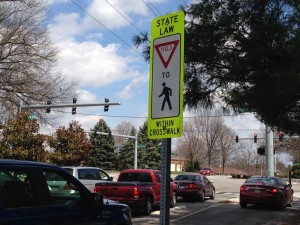
Pedestrian traffic is frustrating and confusing to drivers, too. My recent return to suburban Denver reminded me of how many more people walk there, and perhaps because of that, Denver drivers pay more attention to things like pedestrians crossing. Not far from here on a recent Monday morning, I watched a woman wait as car after car made right turns in front of her despite the fact that she had the right-of-way. And so, we have signs like this one notifying drivers that yes, they have to yield to pedestrians.
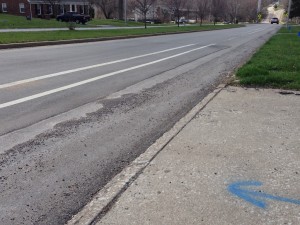
Last summer, the city painted a bike lane along Lansdowne. This road is a natural bike route and was already identified on biking maps of Lexington as a bike-friendly street (there may have been existing signage as well). I’m glad the city added the lane lines. But again, it exposes some of the challenges, some of the behavior changes that need to occur. Many drivers ignore the lines, sometimes driving for extended periods within not just the first line but also the 2nd line. In the meantime, the curb side of the lane is filled with loose aggregate for long stretches. As a bicyclist, this is a bad mix–a hilly, curvy road with a treacherous surface on one side and operators of 2-ton machines who aren’t expecting to see a bicycle on the other side. There is not a lot of room for error here. If more bicyclists rode along Lansdowne, drivers would probably be more cautious, and when drivers are more cautious, perhaps the road will seem a little less treacherous and more people will consider riding.
City leaders are heeding the advice of bike/walk proponents and moving in the right direction, but it will take incremental, iterative change among ourselves to get the city to become multi-mode friendly.
